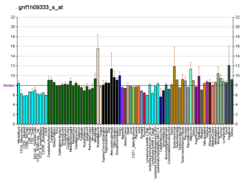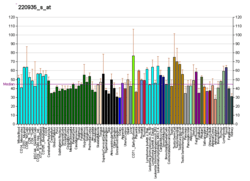CDK5RAP2
CDK5 regulatory subunit-associated protein 2 is a protein that in humans is encoded by the CDK5RAP2 gene. It has necessary roles in the formation and stability of microtubules from the centrosome[5] and has been found to be linked to human brain size variation in males.[6] Multiple transcript variants exist for this gene, but the full-length nature of only two has been determined.[7][8]
CDK5RAP2 is homologous to the Drosophila protein centrosomin (cnn)[9] and paralogous to myomegalin, which in mammals contains an Olduvai domain, a domain implicated in human brain size evolution.[10][11]
Function
CDK5RAP2 is necessary for the proper formation, anchoring and orientation of microtubules from the centrosome. It binds with the γ-tubulin ring complex (γTuRC), and this is required for the γTuRC to attach to the centrosome.[5] CDK5RAP2 also binds to p25, a form of CDK5R1 that serves as the activating subunit of CDK5, which is involved in the regulation of neuronal differentiation. CDK5RAP2 therefore has a role in neuronal differentiation.[8] CDK5RAP2 is also necessary as a scaffolding protein in the centrosomal corona of Dictyostelium.[12]
Clinical significance
Human brain size variation
An MRI study has demonstrated a link between common human variation in the CDK5RAP2 gene and brain structure. More specifically, associations were found between several single nucleotide polymorphisms (SNPs) and brain cortical surface area and total brain volume. These associations were found exclusively in male subjects, and all SNPs were located either in the last 7 introns or downstream of the gene. The functional significance of these loci is not yet known. However, given their location close to regulatory elements, it is possible that they are involved in gene regulation, which suggests that common variance in brain structure could be associated with differences in gene regulation rather than protein structure, consistent with findings in other complex human traits.[6] CDK5RAP2 is a paralogue of myomegalin, which in mammals contains an Olduvai domain, a domain with human-specific duplications that have been implicated in human brain size evolution.[10][11]
Autosomal recessive primary microcephaly
Mutations in CDK5RAP2 cause autosomal recessive primary microcephaly type 3.[13][5]
Interactions
CDK5RAP2 has been shown to interact with CDK5R1[14] and pericentrin (PCTN).[8]
History
The gene was discovered in 2000[15] and was first characterised in 2007.[5]
References
- GRCh38: Ensembl release 89: ENSG00000136861 - Ensembl, May 2017
- GRCm38: Ensembl release 89: ENSMUSG00000039298 - Ensembl, May 2017
- "Human PubMed Reference:". National Center for Biotechnology Information, U.S. National Library of Medicine.
- "Mouse PubMed Reference:". National Center for Biotechnology Information, U.S. National Library of Medicine.
- Fong KW, Choi YK, Rattner JB, Qi RZ (January 2008). "CDK5RAP2 is a pericentriolar protein that functions in centrosomal attachment of the gamma-tubulin ring complex". Molecular Biology of the Cell. 19 (1): 115–25. doi:10.1091/mbc.E07-04-0371. PMC 2174194. PMID 17959831.
- Rimol LM, Agartz I, Djurovic S, Brown AA, Roddey JC, Kähler AK, et al. (January 2010). "Sex-dependent association of common variants of microcephaly genes with brain structure". Proceedings of the National Academy of Sciences of the United States of America. 107 (1): 384–8. doi:10.1073/pnas.0908454107. PMC 2806758. PMID 20080800.
- Ching YP, Qi Z, Wang JH (January 2000). "Cloning of three novel neuronal Cdk5 activator binding proteins". Gene. 242 (1–2): 285–94. doi:10.1016/S0378-1119(99)00499-0. PMID 10721722.
- "Entrez Gene: CDK5RAP2 CDK5 regulatory subunit associated protein 2".
- Barr AR, Kilmartin JV, Gergely F (April 2010). "CDK5RAP2 functions in centrosome to spindle pole attachment and DNA damage response". The Journal of Cell Biology. 189 (1): 23–39. doi:10.1083/jcb.200912163. PMC 2854379. PMID 20368616.
- Dumas L, Kim YH, Karimpour-Fard A, Cox M, Hopkins J, Pollack JR, Sikela JM (September 2007). "Gene copy number variation spanning 60 million years of human and primate evolution". Genome Research. 17 (9): 1266–77. doi:10.1101/gr.6557307. PMC 1950895. PMID 17666543.
- O'Bleness MS, Dickens CM, Dumas LJ, Kehrer-Sawatzki H, Wyckoff GJ, Sikela JM (September 2012). "Evolutionary history and genome organization of DUF1220 protein domains". G3. 2 (9): 977–86. doi:10.1534/g3.112.003061. PMC 3429928. PMID 22973535.
- Pitzen V, Askarzada S, Gräf R, Meyer I (April 2018). "CDK5RAP2 Is an Essential Scaffolding Protein of the Corona of the Dictyostelium Centrosome". Cells. 7 (4). doi:10.3390/cells7040032. PMC 5946109. PMID 29690637.
- "OMIM Entry - # 604804 - MICROCEPHALY 3, PRIMARY, AUTOSOMAL RECESSIVE; MCPH3". www.omim.org. Retrieved 2020-01-06.
- Wang X, Ching YP, Lam WH, Qi Z, Zhang M, Wang JH (October 2000). "Identification of a common protein association region in the neuronal Cdk5 activator". The Journal of Biological Chemistry. 275 (41): 31763–9. doi:10.1074/jbc.M004358200. PMID 10915792.
- Ching YP, Qi Z, Wang JH (January 2000). "Cloning of three novel neuronal Cdk5 activator binding proteins". Gene. 242 (1–2): 285–94. doi:10.1016/S0378-1119(99)00499-0. PMID 10721722.
Further reading
- Moynihan L, Jackson AP, Roberts E, Karbani G, Lewis I, Corry P, et al. (February 2000). "A third novel locus for primary autosomal recessive microcephaly maps to chromosome 9q34". American Journal of Human Genetics. 66 (2): 724–7. doi:10.1086/302777. PMC 1288125. PMID 10677332.
- Wang X, Ching YP, Lam WH, Qi Z, Zhang M, Wang JH (October 2000). "Identification of a common protein association region in the neuronal Cdk5 activator". The Journal of Biological Chemistry. 275 (41): 31763–9. doi:10.1074/jbc.M004358200. PMID 10915792.
- Nagase T, Kikuno R, Nakayama M, Hirosawa M, Ohara O (August 2000). "Prediction of the coding sequences of unidentified human genes. XVIII. The complete sequences of 100 new cDNA clones from brain which code for large proteins in vitro". DNA Research. 7 (4): 273–81. doi:10.1093/dnares/7.4.271. PMID 10997877.
- Ching YP, Pang AS, Lam WH, Qi RZ, Wang JH (May 2002). "Identification of a neuronal Cdk5 activator-binding protein as Cdk5 inhibitor". The Journal of Biological Chemistry. 277 (18): 15237–40. doi:10.1074/jbc.C200032200. PMID 11882646.
- Nakayama M, Kikuno R, Ohara O (November 2002). "Protein-protein interactions between large proteins: two-hybrid screening using a functionally classified library composed of long cDNAs". Genome Research. 12 (11): 1773–84. doi:10.1101/gr.406902. PMC 187542. PMID 12421765.
- Andersen JS, Wilkinson CJ, Mayor T, Mortensen P, Nigg EA, Mann M (December 2003). "Proteomic characterization of the human centrosome by protein correlation profiling". Nature. 426 (6966): 570–4. doi:10.1038/nature02166. PMID 14654843.
- Bond J, Roberts E, Springell K, Lizarraga SB, Lizarraga S, Scott S, et al. (April 2005). "A centrosomal mechanism involving CDK5RAP2 and CENPJ controls brain size". Nature Genetics. 37 (4): 353–5. doi:10.1038/ng1539. PMID 15793586.
- Nousiainen M, Silljé HH, Sauer G, Nigg EA, Körner R (April 2006). "Phosphoproteome analysis of the human mitotic spindle". Proceedings of the National Academy of Sciences of the United States of America. 103 (14): 5391–6. doi:10.1073/pnas.0507066103. PMC 1459365. PMID 16565220.
- Evans PD, Vallender EJ, Lahn BT (June 2006). "Molecular evolution of the brain size regulator genes CDK5RAP2 and CENPJ". Gene. 375: 75–9. doi:10.1016/j.gene.2006.02.019. PMID 16631324.
- Olsen JV, Blagoev B, Gnad F, Macek B, Kumar C, Mortensen P, Mann M (November 2006). "Global, in vivo, and site-specific phosphorylation dynamics in signaling networks". Cell. 127 (3): 635–48. doi:10.1016/j.cell.2006.09.026. PMID 17081983.
External links
- Human CDK5RAP2 genome location and CDK5RAP2 gene details page in the UCSC Genome Browser.





